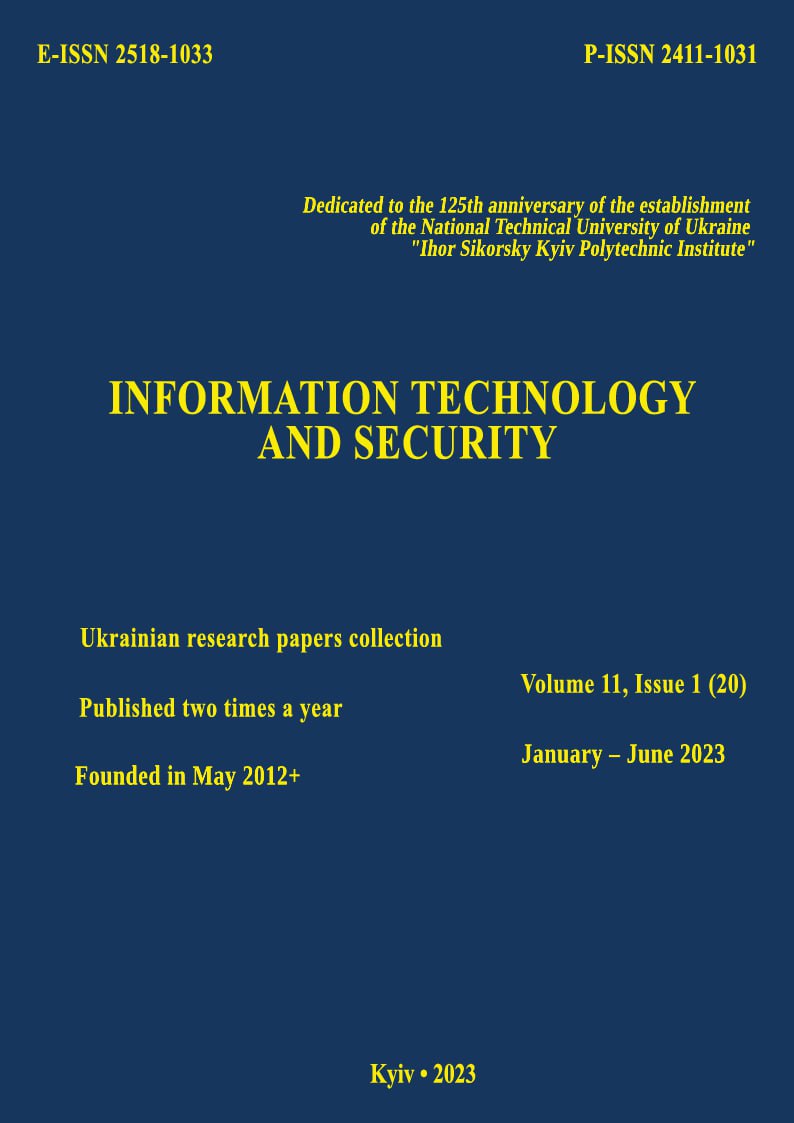Method of calculating of the information in social networks protection depending on the number of communities
DOI:
https://doi.org/10.20535/2411-1031.2023.11.1.279868Keywords:
social network, number of communities, security system, non-linearity, differential equationAbstract
A mathematical model (linear system of differential equations) was developed and a research of the model of personal data protection against the number of communities and the intensity of data transfer in social networks was conducted. The linear system of information protection in social networks in the mathematical sense of this term is considered. When described by linear models, the object should be linear, at least approximately. This approach makes it quite simple to consider mathematical models. If such a thing is not noticed, it is necessary to examine the security system for linearity. Such dependecies has been studied: the dependence of the amount of information flow in the social network on the components of information protection, the amount of personal data, and the speed of the data flow; the security of the system on the size of the system (as well as on the amount of personal data); information security threats on the number of communities, and also calculated: – coefficient representing the impact of information protection measures; – coefficient representing the impact of data leakage rate; – the coefficient representing the influence of the amount of data on its leakage; – the coefficient representing the influence of the system size on system security; – coefficient representing the impact of system security on data leakage; – the number of connections in the social networks; – number of vertices in the social networks; – the parameter can be used to configure the network partitioning algorithm. The solution has been obtained - the harmonic oscillator equation, which breaks down into three cases: pre-resonance zone, resonance zone and post-resonance zone. So, the impact of the parameters of the number of communities on the parameters of the social network security system was investigated. Such a study is useful and important from the point of view of information protection in the network, since the parameters of the number of communities has significant influence, up to 100%, per protection indicator. As the result of research, it was established that social network security systems are non-linear.
References
V. Akhramovych, S. Lazarenko, H. Martynyuk, and Yu. Balanyuk, “Social network communities’ search model”, Ukrainian scientific journal of information security, vol. 26, no. 1, pp. 35-41, 2020, doi: https://doi.org/10.18372/2225-5036.26.14668.
N. Bailey, “The mathematical theory of infectious diseases and its applications”, New York, USA: Hafner Press, 1975.
F. Cohen, “Computer viruses, theory and experiments”, Computers & Security. vol. 6, рр. 22-35, 1987.
D. Gubanov, and A. Chkhartishvili, “A conceptual approach to the analysis of online social networks”, Upravlenie bol'shimi sistemami – Large-Scale Systems Control, No. 45, pp. 222−23, 2013.
J. Kephart, and S. White, “Directed-graph D. Gubanov, and A. Chkhartishvili, “A conceptual approach to the analysis of online social networks”, Automation and Remote Control, vol. 76(8), pp. 1455-1462, 2015, doi: https://doi.org/10.1134/S000511791508010X.
V. Savchenko, V. Akhramovych, T. Dzyuba, S. Laptiev, N. Lukova-Chuiko, and T. Laptievа, “Methodology for calculating information protection from parameters of its distribution in social networks”. in Proc. IEEE 3rd International Conference on Advanced Trends in Information Theory (ATIT), Kyiv, 2021, pр. 99-105, doi: https://doi.org/10.1109/ATIT54053.2021.9678599.
O. Laptiev, V. Savchenko, A. Kotenko, V. Akhramovych, V. Samosyuk, G. Shuklin, and A. Biehun, “Method of determining trust and protection of personal data in social networks”, International journal of communication networks and information security (IJCNIS), № 1, pр. 15-21, 2021, doi: https://doi.org/10.17762/ijcnis.v13i1.4882.
V. Akhramovych, G. Shuklin, Y. Pepa, T. Muzhanova, and S. Zozuli, “Devising a procedure to determine the level of informational space security in social networks considering interrelations among users”, Eastern European Journal of Advanced Technologies, no. 1/9 (115). рр. 63-74, 2022, doi: https://doi.org/10.15587/1729-4061.2022.252135.
M. M. Williamson, and J. Léveillé, “An epidemiological model of virus spread and cleanup”, Hewlett-Packard Laboratories, February 27th, 2003. [Online]. Available: https://www.hpl.hp.com/techreports/2003/HPL-2003-39.pdf. Accessed on: Apr. 21, 2023.
Y. Zan, J. Wu, P. Li, and Q. Yu, “SICR rumor spreading model in complex networks: counterattack and self-resistance”, Physica A: Statistical Mechanics and its Applications, vol. 405, pp. 159-170, 2014.
Y. Zhang, and J. Zhu, “Stability analysis of I2S2R rumor spreading model in complex networks”, Physica A: Statistical Mechanics and its Applications, vol. 503, pp. 862-881, 2018.
N. Zhao, and X. Cheng, “Impact of information spread and investment behavior on the diffusion of internet investment products”, Physica A: Statistical Mechanics and its Applications, vol. 512, pp. 427-436, 2018.
D. Trubetskov, Introduction to synergetics. Chaos and Structures, 2nd ed. rev. and add. Moscow: Editorial URSS, 2004.
Downloads
Published
How to Cite
Issue
Section
License
Copyright (c) 2023 Collection "Information Technology and Security"

This work is licensed under a Creative Commons Attribution 4.0 International License.
The authors that are published in this collection, agree to the following terms:
- The authors reserve the right to authorship of their work and pass the collection right of first publication this work is licensed under the Creative Commons Attribution License, which allows others to freely distribute the published work with the obligatory reference to the authors of the original work and the first publication of the work in this collection.
- The authors have the right to conclude an agreement on exclusive distribution of the work in the form in which it was published this anthology (for example, to place the work in a digital repository institution or to publish in the structure of the monograph), provided that references to the first publication of the work in this collection.
- Policy of the journal allows and encourages the placement of authors on the Internet (for example, in storage facilities or on personal web sites) the manuscript of the work, prior to the submission of the manuscript to the editor, and during its editorial processing, as it contributes to productive scientific discussion and positive effect on the efficiency and dynamics of citations of published work (see The Effect of Open Access).

